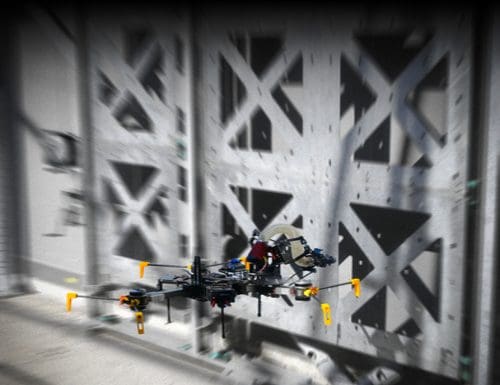
New research from Imperial College London and the University of Bristol has explored the emerging field of utilising aerial robotics in construction, with new drone technology undergoing tests in Switzerland
Published in Science Robotics, the research examines the use of drones for mid-air material deposition in the construction industry – a process known as Aerial Additive Manufacturing (Aerial AM).
Aerial AM could provide wide-ranging benefits to the safety, sustainability and scale of construction.
Flying construction robots present new building potential
Without the obvious limits of ground-based robotics, flying construction robots could operate in inaccessable areas or at a height, reducing the risks posed to a human workforce carrying out the same work.
The paper also introduces an autonomy framework tailored for Aerial AM, addressing critical challenges such as flight coordination, material deposition precision, and scalability in large-scale manufacturing tasks.
The new technology is now being tested at the DroneHub, which is based in Switzerland at EMPA – the Swiss Federal Laboratories for Materials, Science and Technology which provides a platform on which flying construction machines can be tested outside the laboratory for the first time.
Early tests have demonstrated “rapid on-demand repairs” and modular assembly techniques
Dr Basaran Bahadir Kocer, co-author from the University of Bristol’s School of School of Civil, Aerospace and Design Engineering, said: “Despite promising advancements, the deployment of aerial robots for large-scale autonomous construction remains in its infancy.
“Key obstacles include material durability, localisation systems for outdoor environments, and coordination among multiple aerial units.
“Addressing these challenges is essential to unlocking the full potential of Aerial AM in real-world applications. However, early-stage demonstrations of Ariel AM have already showcased capabilities such as rapid on-demand repairs and modular assembly techniques, paving the way for broader adoption across industries.”
Successful collaboration between the University of Bristol and EMPA through fully-funded PhD studentships allows for further utilisation of this resource, in addition to infrastructures at the University of Bristol, including the Flight Lab, Bristol Robotics Lab and Aerial Robotics Group.
You can read the paper in full here.
The post Flying construction robots undergoing first tests in site-like conditions appeared first on Planning, Building & Construction Today.

